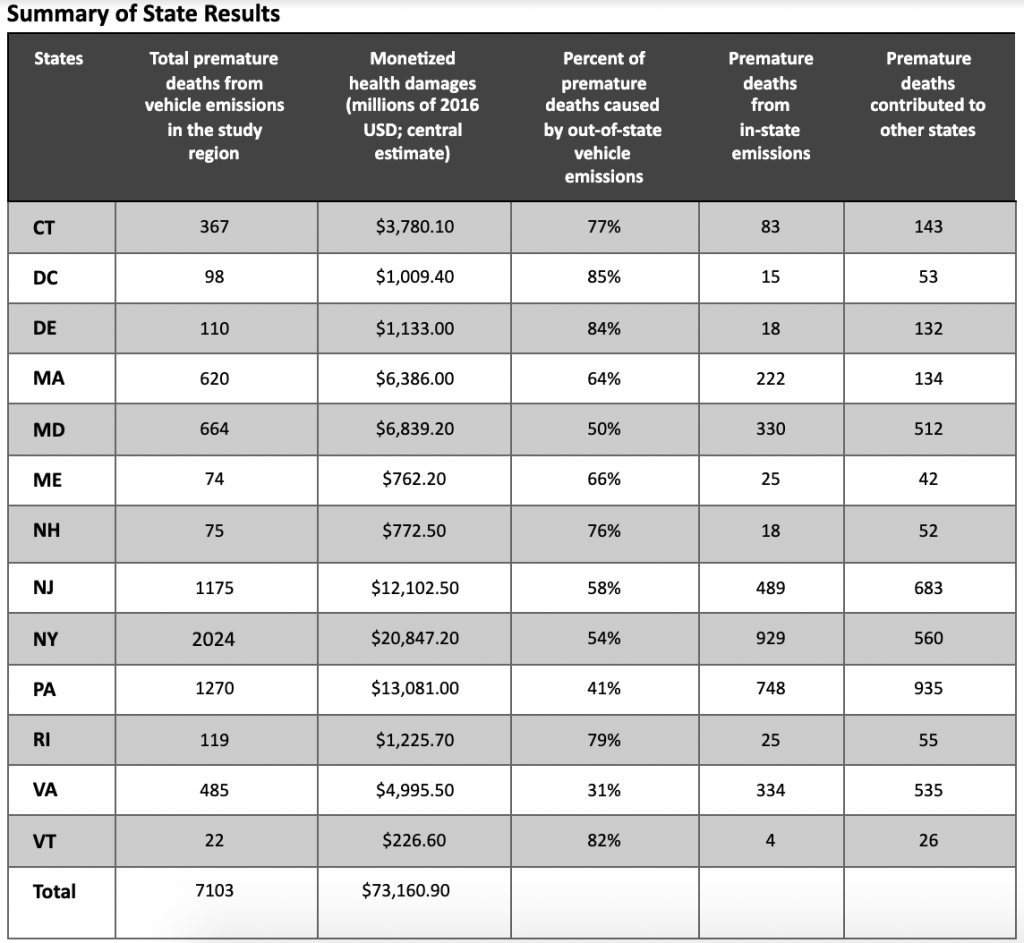A study that quantifies the total and interstate deaths from transportation-related air pollution from five vehicle types in 12 states and Washington, D.C. has been published in Environmental Research Letters. The research was led by researchers at the University of North Carolina at Chapel Hill with the Center for Climate, Health, and the Global Environment at Harvard T.H Chan School of Public Health.
The study is part of the Transportation, Equity, Climate, and Health project (TRECH), a multi-university research team from Harvard T.H. Chan School of Public Health, Boston University, University of North Carolina, and Columbia University, which analyzes policy scenarios to address carbon pollution from the transportation sector.
Key Takeaways
- Ozone and fine particulate matter from vehicle emissions in 2016 led to an estimated 7,100 deaths in the Northeast and Mid-Atlantic regions of the U.S., and pollution from tailpipe emissions is also traveling across state lines, harming the health of people living in cities and states downwind.
- Region wide, light-duty trucks, which include SUVs, were responsible for the largest number of premature deaths at 2,463 followed by light-duty passenger vehicles (1,881) and heavy-duty trucks (1,465)
- All states experienced substantial health impacts from vehicle emissions and can gain health benefits from local action.
- New York, Pennsylvania, and New Jersey were hardest hit with health damages at $21 billion, $13 billion, and $12 billion, respectively, in 2016 (the most recent data available from EPA).
- Many states are heavily impacted by out-of-state emissions and some states cause more deaths out-of-state than in-state, including PA and NJ, highlighting the importance of region-wide action to reduce vehicle emissions.
- On a ton for ton basis, buses in the New York-Newark-Jersey City metropolitan area had the largest health damages at $4 million for every ton of particulate matter emitted.
- Ammonia emissions play a stronger relative role in causing health damages compared to oxides of nitrogen. Regionally, ammonia emissions from vehicles were responsible for 740 premature deaths in 2016, more than 10% of the total deaths. Ammonia emissions from vehicles are an unintended by-product of catalytic converters and are unregulated in the U.S., and their role in urban air pollution has been generally under appreciated.
Policy Insights
- “The research confirms that recent efforts to electrify the bus fleet in New York City will have large health benefits—or, biggest bang for the buck. The cross-border impacts underscore the need for region-wide action to curb transportation emissions.” —Saravanan Arunachalam, research professor and deputy director of the UNC Institute for the Environment.
- “The particular source region and type of vehicle responsible for the most health problems vary across the region. While particulate matter from New York City buses has the largest impact per ton of emissions in New York, in Massachusetts it’s heavy-duty trucks in Boston, and in Virginia it is light-duty autos. As policymakers consider how to transform the transportation sector—the largest source of carbon pollution—this research offers a roadmap for where to target investments to most cost-effectively improve air quality and health.” —Jonathan Buonocore, Research Scientist at Harvard Chan C-CHANGE.
Supplementary Data
Authors
Calvin Arter, University of North Carolina; Jonathan Buonocore, Harvard Chan C-CHANGE; Charles Chang, UNC Institute for the Environment; Charles Chang, UNC Institute for the Environment; Saravanan Arunachalam, UNC Institute for the Environment.
Related
- Read the study in Environmental Research Letters
- Read the press release
- Download the presentation of findings (PDF)
Related Media

